|
2. Thymelicus sylvestris (Poda, 1761) / Small skipper / Hesperiidae – Hesperiinae
NL: geelsprietdikkopje / D: Ockergelber Dickkopffalter, Braunkolbiger Braun-Dickkopffalter / F: hespérie de la houlque, bande noir
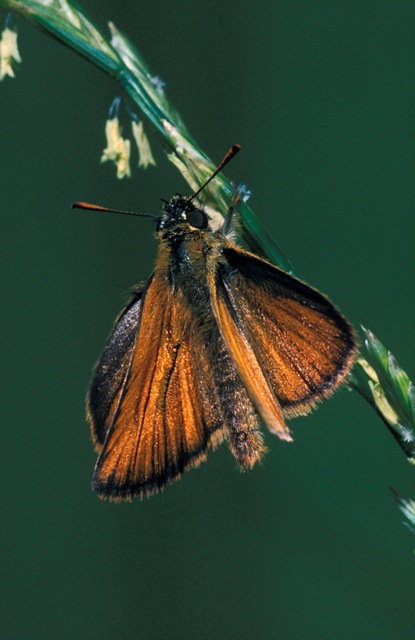 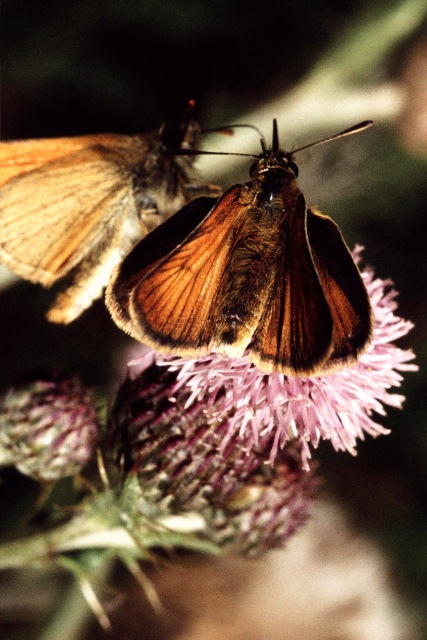 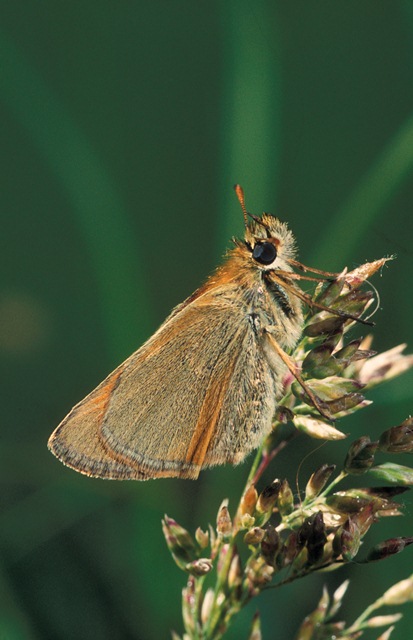
Photographs: Frits Bink ©.
Very small or small, wing length 14 (12-15) mm. It is widely spread but local in the Benelux; it is rare in dunes, more common on heathland, marshes, grassland and little grazed meadows. In the countryside it occurs at woodland edges, roadside verges, rides and railway embankments. The species may be observed together with the very similar species Thymelicus lineola, but differs in its ecology by preferring humid sites, thus the former occurs also in reed fringed marshes.
Adult is on the wing from mid-June until mid-August, peaking in mid-July. It occurs in maritime and continental climates, the amplitude ranges from 5 to 17; requires heat sum 600°d and tolerates up to 2300°d. The corresponding climate windows are 22 and 31 weeks.
The distribution in Europe of this species is less northerly than T. lineola. T. sylvestris occurs in Denmark up to the north of Jutland (c. 58°) whereas T. lineola meets its northern limit near Stockholm, Sweden (c. 59°).
The survival of local populations depends on places with tall grass in which the young larvae can overwinter.
Ecological characteristics
Behaviour over time
Overwintering: as a newly born larva in a silky cocoon, hidden in an enrolled, withered grass blade, together with 10-40 others from the same egg batch.
Reproduction: oviposition starts after 5-6 days when the body contains 62 (53-71) eggs, estimated potential production twice that.
Larval feeding periods: about 10 weeks from early-April until end-June.
Generations: always one.
Spreading of risk: not observed.
Life cycle: egg 20 (15-33) days; larva 46 weeks; pupa 16 (12-22) days.
Life span of adult: rather long, 3 weeks.
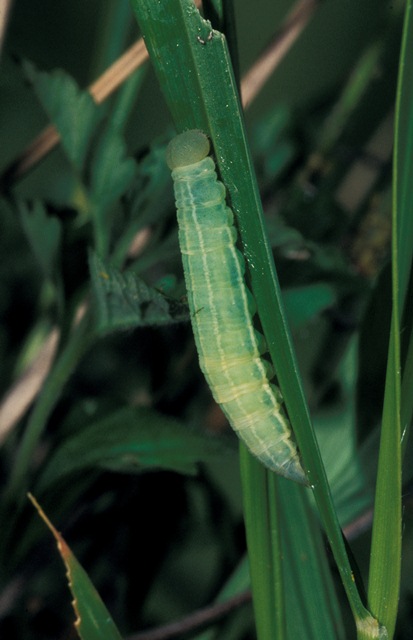 
Photographs: Frits Bink ©.
Behaviour in space
From stay-at-home to migrant: stay-at-home, spatial requirement very modest.
Finding a mate: the sexes meet each other on flowers like thistle.
Orientation in the landscape: on edges of low and tall grass in a park like landscape.
Oviposition: in withered leaf at the junction with the grass stem, female deposits up to 48 eggs in a row with her wedge like ovipositor into the sheath.
Defence
Threats from other organisms: larva hides in a tube of enrolled leaf.
Threats from the environment: the insects are susceptible of adverse weather in spring and summer.
Feeding habits
Adult: nectar only, flowers with deep nectar can be used because the butterfly is equipped with a long proboscis of 16 mm.
Larva: in the very early stage the caterpillar needs young shoots of grass, later on it lives in a tube where it eats the upper part and later lives freely on a leaf.
Larval foodplants
Plant species: Poaceae, tall grasses as Alopecurus pratensis, Brachypodium pinnatum, B. sylvaticum, Calamagrostis canescens, Elymus repens, Festuca pratensis.
Journal
Rearing experiments based on specimens originating from national park Hoge Veluwe, Netherlands:
11 July 1983: five females captured and dissected.
30 July 1984 three females captured at the same locality.
5 August: around 16 eggs found in withered leaf, female empty, other one died and had 42 eggs in the body.
6 August: a row of 48 eggs in a sheath of a wilted leaf of Poa trivialis, deposited by a single female, 13 remaining eggs in the body.
17 August fully developed larvae seen in the eggs.
7 September: cocoons discovered and one fresh larva still crawling around.
Overwintered indoors.
27 March 1985: in the greenhouse one larva present in the heart of the tussock and had already taken some food.
6 April: larva now ending its first instar.
23 April: larva in second instar.
10 May: larva in moult L2-3, put on Brachypodium pinnatum to continue its development.
30 May: now L5, leaves its cradle when disturbed and drops to the ground.
6 June: larva fully grown.
7 June: starts pupating, spins a loose cocoon.
9 June: pupated, pupa has an extended proboscis sheet up to the cremaster point.
1 July: hatched, egg load: 8 very small eggs in the ovariole
Table 2-1. Results of dissections

Table 2-2. Collection and observation localities
D, Arnstein 50° 01’ 57”N – 9° 47’ 41”E; 22 July 1984.
D, Flögeln 53° 40’ 47”N – 8° 48’ 37”E; 15 July 2005.
D, Kaiserstuhl, Badberg 433 m, 48° 05’ 47”N – 7° 40’ 40”E; 9 July 1985.
DK, Gundersted 56° 55’ 08”N – 9° 26’ 31”E; 10 July 2005.
B, Ethe, 240 m, 49° 36’ 25”N – 5° 35’ 50”E; 11 July 84.
F, Lorraine, Dieue-sur Meuse 49° 05’ 11”N – 5° 27’ 25”E; 11 July 1984, 19 August 1984, 10 July 1985.
F, Lorraine, Lion-devant-Dun 300m, 49° 23’ 40”N – 5° 14’ 03”E; 11 July 84.
F, Montmédy 217m, 49° 31’ 07”N – 5° 21’ 33” E; 18 August 1984.
F, Vosges, Grand Ballon 1424m, 47° 54’ 04”N – 7° 05’ 54”E; 26 July 1983.
F, Vosges, Hohneck 1283m, 48° 02’ 03”N – 7° 02’ 27”E; 23 July 1983.
F, Vosges, le Steinberg 1150m, 47° 59’ 27”N – 7° 06’ 40”E; 21 August 1984.
F, Vosges, le Zinnkoepfle 481 m, 47° 57’ 56”N – 7° 15’ 08”E; 3 September 1981, 10 July 1984.
GB, Surry, Dorking 51° 14’ 32”N - 0° 21’ 13”W; 23 July 1981.
GB, Surry, Frensham Great Park 51° 09’ 28”N - 0° 47’ 26”W; 21 July 1981.
GB, Oxford, Great Wood 51° 41’N – 0° 55’W; 20 July 1981.
L, Kautenbach 316m, 49° 57’18”N – 6° 00’ 59”E; 21 June 2006.
NL, Hoge Veluwe 52° 05’N – 5° 51’E; 11 July 1983, 30 July 1984.
NL, Hoge Veluwe 40m, 52° 04’ 47”N – 5° 49’ 47”E; 27 July 2000, 31 August 2000.
(Supplier Klaas Stoker 7 females 13 August 1984).
Fig. 2-1. Thymelicus sylvestris, phenogram adapted from Fichefet et al. 2008: 61.
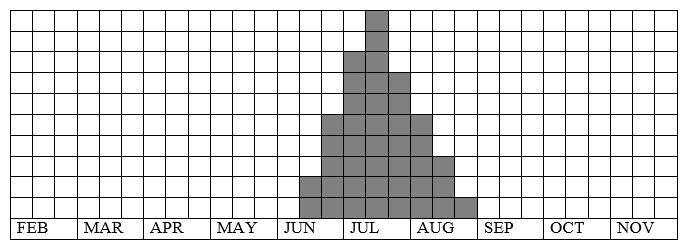
Fig. 2-2. Thymelicus sylvestris, habitat characteristics.
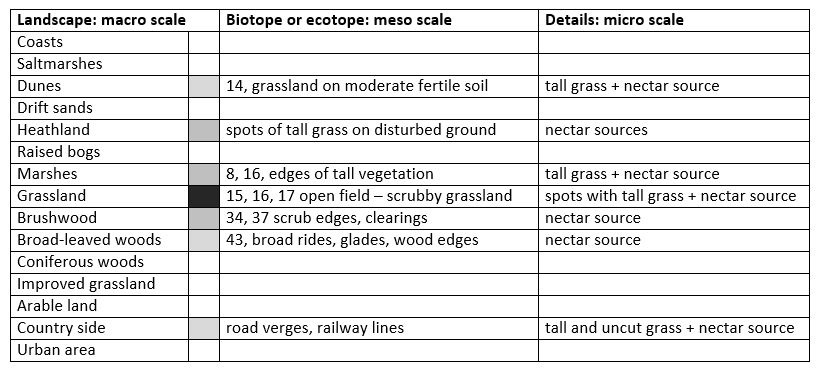
Fig. 2-3.Thymelicus sylvestris, climate matrix, heat-sums 600 - 2300°d.
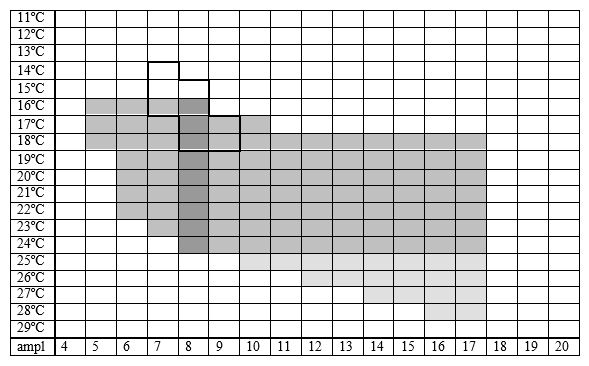
|










